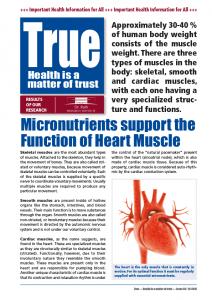- Have any questions? Contact us!
- info@dr-rath-foundation.org

Connective Tissue Diseases and the Heart Disease Connection
October 4, 2017
The Importance of Minerals in Optimum Function of the Heart and other Muscles
October 4, 2017Micronutrients Support the Function of Heart Muscle

 Approximately 30-40 % of human body weight consists of the muscle weight. There are three types of muscles in the body: skeletal, smooth and cardiac muscles, with each one having a very specialized structure and functions.
Approximately 30-40 % of human body weight consists of the muscle weight. There are three types of muscles in the body: skeletal, smooth and cardiac muscles, with each one having a very specialized structure and functions.
Skeletal muscles are the most abundant types of muscles. Attached to the skeleton, they help in the movement of bones. They are also called striated or voluntary muscles, because movement of skeletal muscles can be controlled voluntarily. Each of the skeletal muscles is supplied by a specific nerve to coordinate voluntary movements. Usually multiple muscles are required to produce any particular movement.
Smooth muscles are present inside of hollow organs like the stomach, intestines, and blood vessels. Their main function is to move substances through the organ. Smooth muscles are also called non-striated, or involuntary muscles because their movement is directed by the autonomic nervous system and is not under our voluntary control.
Cardiac muscles, as the name suggests, are found in the heart. These are specialized muscles as they are structurally similar to skeletal muscles (striated). Functionally, however, due to their involuntary nature they resemble the smooth muscles. These muscles are present only in the heart and are responsible for pumping blood. Another unique characteristic of cardiac muscle is that its contraction and relaxation rhythm is under the control of the “natural pacemaker” present within the heart (sinoatrial node), which is also made of cardiac muscle tissue. Because of this property, cardiac muscle is considered auto-rhythmic by the cardiac conduction system.
Unlike skeletal and smooth muscles, the cardiac muscles are the only ones that have to work constantly at the same pace throughout our life. The human heart pumps approximately 5 liters of blood throughout the body every single minute. It is not surprising that cardiac muscles need a constant supply of nutrients to function continuously and optimally. When the body experiences chronic deficiency of essential micronutrients, the effects are distinctly noticeable with suboptimal heart function, which manifests in the form of various diseases such as cardiomyopathy, heart valve diseases, irregular heartbeats (arrhythmias), and heart failure. Cardiomyopathy is a disease in which the heart muscle becomes inflamed, enlarged, and rigid, essentially losing its elasticity. This results in reduced blood supply to all the organs in the body and its resultant consequences.
According to our research, most of the diseases of the cardiovascular system occur due to chronic deficiency of certain nutrients and can be prevented by appropriate supplementation. Specifically, the B vitamins, carnitine, taurine, and coenzyme Q-10 are critical micronutrients to support the metabolism and produce essential bioenergy required for optimal cardiac function. However, these micronutrients also need to be supported by other micronutrients that work in synergy with each other and increase the effect of the essential ones. We have seen that such synergy can be achieved by combining the above nutrients with vitamin C, alpha lipoic acid, alpha ketoglutarate and others. Our clinical studies concluded that a specific combination of micronutrients supports the healthy function of heart cells and gives optimum support and bio energy production in the heart muscle.



